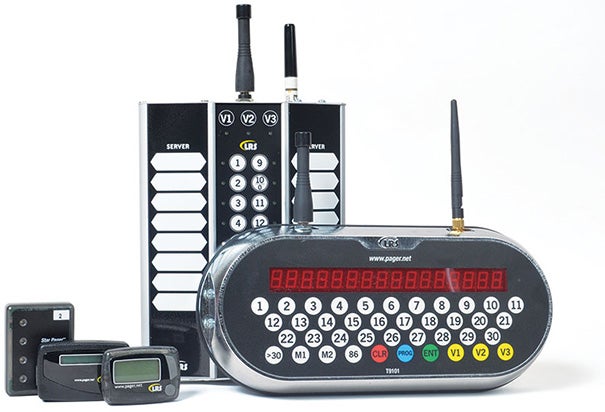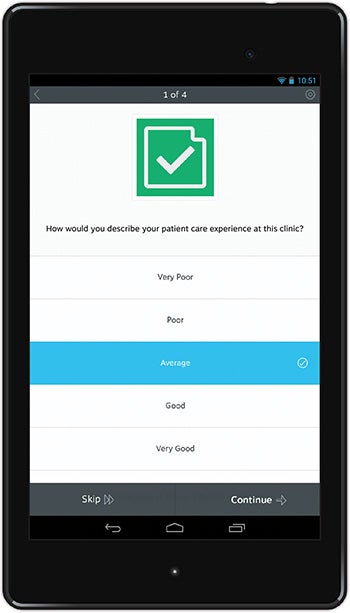Improving patient and staff communication
Doctors have long focused on implementing the latest breakthroughs in patient treatment. Now, health care providers are realizing the benefits technology can have on the patient experience, as well. By implementing better systems of communication between patients and staff, health care facilities are boosting patient satisfaction and their own efficiencies.
Case Study 1: Columbia Orthopedic Group
Columbia Orthopedic Group, Missouri, (COG) set out to remake patient intake and elevate the patient experience. Its previous patient intake process was much like the traditional one seen today –– a paperwork-laden check-in with patient files being shuffled about. It’s also a process in which patients often endure an indeterminate waiting period until a nurse calls out their name.
 |
| Photo courtesy of Long Range Systems An electronic paging system allows staff to communicate easily in larger facilities and can be integrated into the patient intake process. |
This system often skirts the rules set by HIPAA for patient privacy. While waiting, patients sometimes wander from the reception area to use the phone, get coffee or go to the restroom. When the nursing staff calls out a patient’s name and there is no response, staff then has to stop what they are doing and scout the patient.
The challenge: A manual, paper-intensive intake. COG is comprised of 24 specialized physicians and wanted to implement a new process to go with its new state-of-the-art Orthopedic Institute.
COG examined its entire check-in and patient flow process. Duane Epperson, COG’s IT manager said, “The [new] system had to be discreet, reliable, easy for the patients to understand and affordable.” Most critical, the system had to integrate with COG’s existing Web-based PC paging application.
The solution: An integrated, patient-friendly intake. COG’s IT group integrated a patient paging solution to work with its proprietary desktop paging app. It then equipped each PC in the facility with the software. This allowed patient notification throughout the facility.
Now, when a patient checks in, the COG reception staff hands them a small coaster pager. The receptionist enters the patient’s name, pager number and doctor’s name into the Web page. The system sends information to all PCs in the system, alerting the rest of the staff that the patient has checked in. When an exam room is ready, the nursing staff clicks a button on their PC, which signals the patient’s pager and removes the patient from the waiting list. The nurse confirms the patient’s identity and leads them inside.
From the patient’s perspective, it’s simple. They check in and receive a small pager. Knowing that they will be quietly notified when the doctor is ready to see them gives the patient peace of mind during the waiting process and unchains them from the reception desk. More privacy and less anxiety equate to a better patient experience.
The benefits of patient paging solutions:
- Enhanced patient satisfaction. COG patient satisfaction increased 20 percent using this new system.
- Improved staff efficiency. The staff shuffles less patient paperwork and almost never has to search for “missing” patients.
- Increased patient privacy and HIPAA compliance. Patients are more secure during the wait process, and COG staff no longer leave sensitive paperwork out in the open.
- Tracked patient times. COG now monitors patient wait times for staff performance metrics and process improvement opportunities.
Case Study 2: Blaine Eye Clinic
Patient intake is only one end of the evolution. What goes on behind the doors of the clinic is evolving as well. As physician groups and facilities grow larger, so does the inefficiency of the “sneaker network.”
 |
| Photo courtesy of Long Range Systems Tablet-based surveys eliminate costly paper processes and allow health facilities to get immediate patient feedback. |
The days of putting a sticky note on coworkers’ monitors or calling their desk phones are gone. Medical personnel today are mobile and rarely at their desks. Health care workers need to be able to communicate with staff discreetly and instantly from anywhere in the facility.
The challenge: Disjointed staff coordination. Blaine Eye Clinic (BEC) was expanding into larger facilities. Before, the clinic relied on verbal communication among the staff. In a larger space, hollering across the room wasn’t going to work.
BEC also transitioned from physical to electronic medical records. It wanted a system to reinforce its HIPAA compliance. No more passing charts around the office to get lost or end up in the wrong hands.
According to Nate Sulerud, BEC’s office manager, “With a larger facility, efficient and effective communication between staff was much more of a necessity than ever before.”
The solution: Discreet and instant staff communications. BEC chose a browser-based staff paging solution that works from any PC, tablet or smartphone. Each staff member carries an alphanumeric pager to receive instant messages from other staff members.
Now the reception desk can send a silent page to doctors or technicians informing them about a patient’s arrival or a colleague needing assistance. Physicians can summon a technician or nurse to an examination room without leaving, phoning or shouting. A nurse can let a doctor know that the pre-exam is finished and the patient is ready for them. The result? More efficient patient service with no disruptions.
Sulerud said it’s been a painless transition for the staff. “The implementation was easy and all staff members are able to use the system and enjoy it,” he says.
The benefits of staff paging solutions:
- Fewer on-hold hang-ups. Staff members are alerted to waiting calls no matter where they are so callers don’t hang up in frustration.
- Improved communication and response time. Doctors can instantly request assistance from others from any computer, eliminating the need to go searching for technicians.
- Improved patient flow. Faster response times mean doctors see more patients in less time, increasing BEC’s revenue.
- Increased patient privacy and HIPAA compliance. Eliminating the need to reveal patient details out loud addresses patients’ privacy concerns.
Case Study 3: Auburn University Medical Center
So technology is improving patient intake and staff coordination. What about tracking patients’ satisfaction with the care they received? Hospitals are now required to collect patient feedback through HCAHPS surveys. However, patient surveys often are low on the priority list of clinics and smaller facilities. Not gathering feedback from patients is a missed opportunity to identify areas for improvement and to assess operations and motivate staff.
Even where surveys are a standard practice, many providers still hand or mail the patient a paper comment card. Filling out and returning a survey is usually only a priority for disgruntled patients, which skews the results on an already meager response rate.
The challenge: Increase representative patient feedback. Auburn University Medical Center (AUMC) in Alabama had a challenge with gathering patient feedback. The clinic treats more than 39,000 patients each year. Maintaining the highest possible level of patient satisfaction is a priority, so the clinic collected patient feedback, but via comment cards.
Being on a university campus, AUMC had a higher-than-average 45 percent response rate. Even so, the paper cards seemed old-school to the college’s young demographic. Also, tallying and recording responses took staff approximately 12 hours per month. The system not only cost the clinic too much in staffing expenses on the back end, but the process for handing out and collecting cards from patients also pulled care providers away from their core duties.
The solution: An electronic “point-of-sale” survey with instant feedback. AUMC now offers patients a tablet-based digital survey at the end of their visits. Unlike paper cards, which a patient might not return, this solution presents the patient with an easy way to express their opinions. AUMC’s young patient demographic enjoys the tablet format, and the increase in response rates and positive patient feedback regarding the new system prove it.
The staff receives immediate benefits from the solution, too. It frees up staff members to perform their real function: health care. AUMC’s Marketing Coordinator Meagan Hamner says that the monthly fee for the digital survey application is far less than what the facility was paying a staff member to manually record and analyze the results.
And the feedback is immediate. No more waiting until the end of each month to see trends. The real-time analytics have led to actionable insights. For example, patients expressed some dissatisfaction with aspects of the wait-time experience, prompting AUMC to add televisions to waiting rooms and reorganize patient intake procedures so patients spend less time waiting for a doctor in the exam room.
The benefits of digital patient surveys:
- Improved patient experience. Patients complete a short, tablet-based survey in just seconds at checkout.
- Higher response rates. Response rates can approach 100 percent with immediate feedback.
- Time savings and cost reduction. The solution is electronic, and reporting is automatic, eliminating manual input and calculations. As an added benefit, it costs AUMC less than paying a staff member each month to enter and compile data.
- Improved staff efficiency. Staff can focus on patient care instead of distributing and collecting comment cards.
Updating patient and staff experience to the 21st century
Great service in health care addresses both patient treatment and patient experience. Technology has advanced the ability to deliver on both. There is no better prescription for a healthy guest experience than effective and efficient communication.
John Weber is CEO of Long Range Systems, a leading global provider of technologies that help service businesses deliver a better customer experience. For more information, email jweber@lrsus.com.




